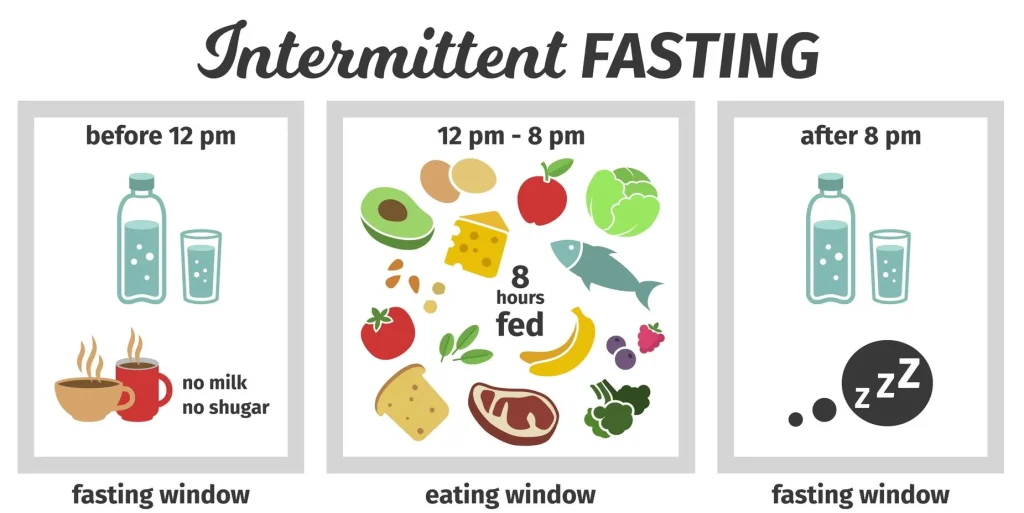
Intermittent Fasting 101
A NEW WAY OF EATING
Intermittent fasting is the concept of alternating between eating and fasting. In order for your body to start receiving any benefits from fasting, you must not consume any calories for at least a 12-hour period. Longer periods offer much more benefits up to 72 hours before diminishing returns.
If you plan to fast for 12 hours then your window to eat is 12 hours. This may sound simple upon hearing it but implementing this into your daily life can be much more of a challenge.
WHY IS THIS A HELPFUL EATING STRATEGY?
At roughly the 12-hour mark, your body enters a stasis of autophagy. Autophagy is your body’s natural way of repairing or removing damaged cells. This process aids in weight loss, heightened immune function, and increased brain activity. Again, the longer you fast the more time autophagy has to work. If you hire a cleaning service to your home and only give them an hour they won’t accomplish much.
INTERMITTENT FASTING SCHEDULES
It is important to adhere to a schedule of fasting that is appropriate to your lifestyle. Luckily there are many different methods that have been tried and tested for your benefit. Let’s go over them.
16:8 (MOST POPULAR)
The 16:8 method of intermittent fasting means that you choose an 8-hour window during your day to consume calories. For the other 16 hours, you fast or consume liquids like water, unsweetened tea, or unsweetened coffee. (NOTE: Bulletproof coffee is acceptable).
The optimal time for your eating window for a typical person is between 12 pm noon and 8 pm in the evening. This gives most people a few hours to digest their food before sleep. With that being said, you don’t have to be so rigid. Just because it’s optimal doesn’t mean that it fits your lifestyle. If you work a night shift it makes sense for your eating window to be much later or much earlier than recommended.
5:2
The 5:2 method of intermittent fasting means that you pick 5 days out of the week to eat a socially normal schedule of breakfast, lunch, and dinner. On the 2 leftover days of the week, you will fast for a 24-hour period. On this diet, not everyone fasts completely, some simply cut back on their calories by only eating 20 percent of the calories they would normally. Although this limits autophagy, it does not limit weight loss if your diet consists of whole foods.
ALTERNATE DAY FASTING
Alternate day fasting intermittent fasting involves the use of fasting every other day. As an example, using Sunday as the beginning of the week, you may eat normally that day. Then, on Monday, you will fast for 24 hours breaking your fast on Tuesday. You will repeat this process until the 7th day and then start the process again the following week.
Remember, for best results, you should be eating whole foods during your feeding days.
THE WARRIOR FAST
This way of fasting is harder and much stricter than the others as the name implies. You are to eat raw fruits and vegetables ONLY in the morning starting at 4 am and before noon. Your eating window after is 4 pm-8 pm. Once 8 pm arrives you will fast until 4 am the next day. This fast requires you to adhere to a paleo diet (I.E. Lean meats, fish, fruits, vegetables, nuts, and seeds.)
Adhering to these timeframes can be a challenge. If you are social, you don’t have a lot of flexibility. Your nutritional needs can also suffer if you don’t have enough diversity in your food palette.
OVERALL BENEFITS
If you suffer from diabetes, decreased brain function, or obesity, intermittent fasting is one of the best practices you can undertake. The ramp-up to beginning to eat this way does have a difficult curb. However, this can be overcome with diet consistency in a matter of weeks.
All of these options are beneficial to achieving a better outcome of health. Especially if you are suffering from any of the foodborne illnesses described above. Choose the method that you will stick to. The one you enjoy the most. Sometimes when practicing diet and nutrition a bit of autonomy is necessary.
If you would like to see some great options of foods to eat during your feeding windows, check out our recipe guide!

Leave a Reply
You must be logged in to post a comment.